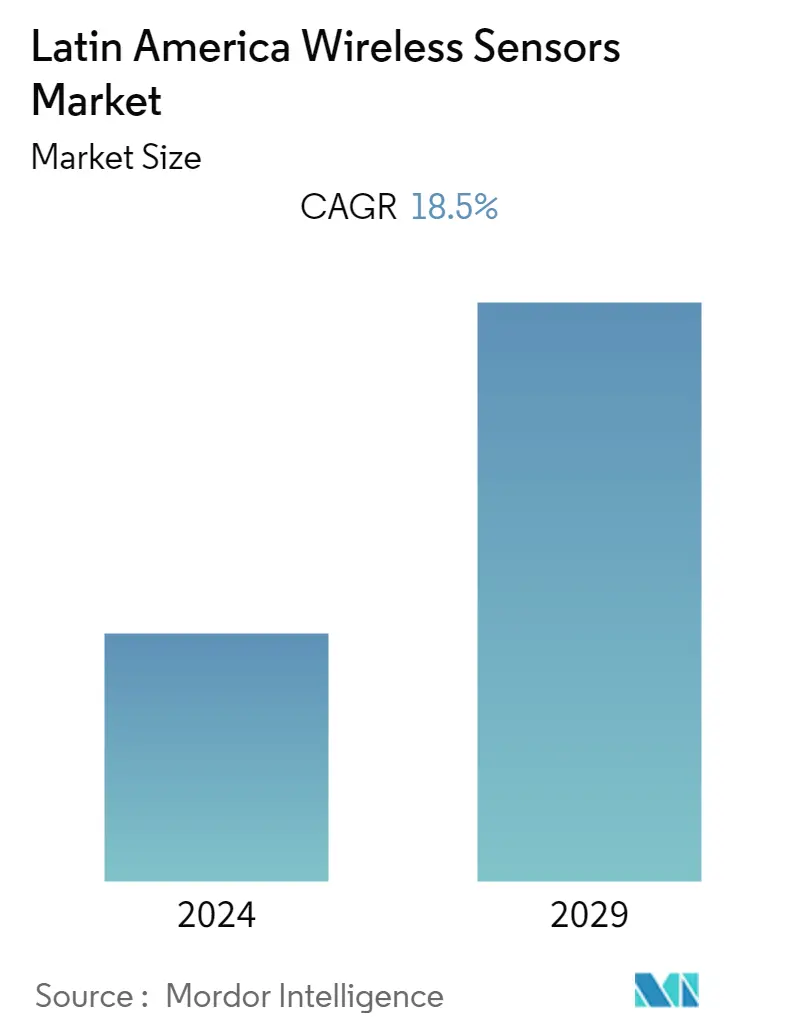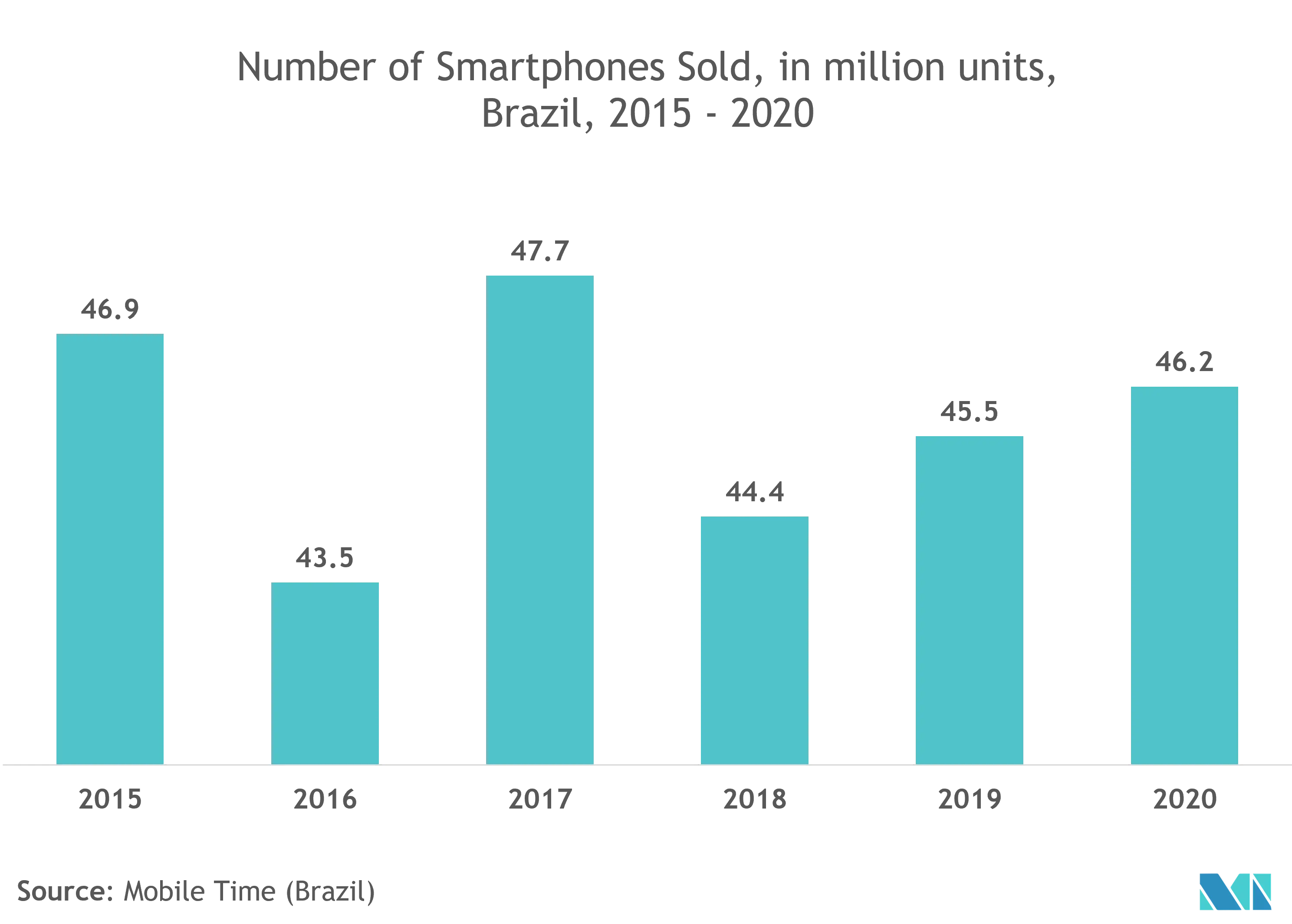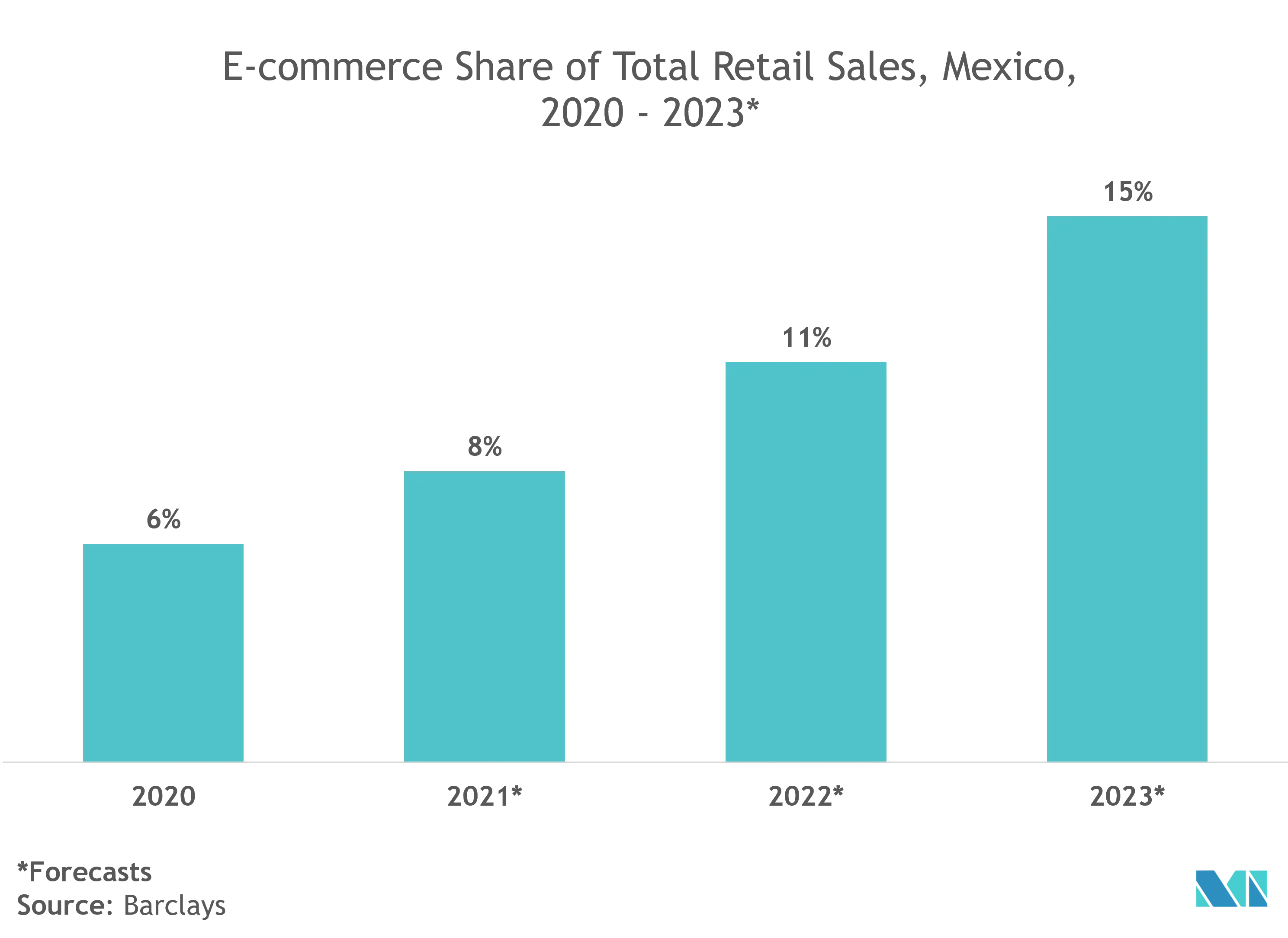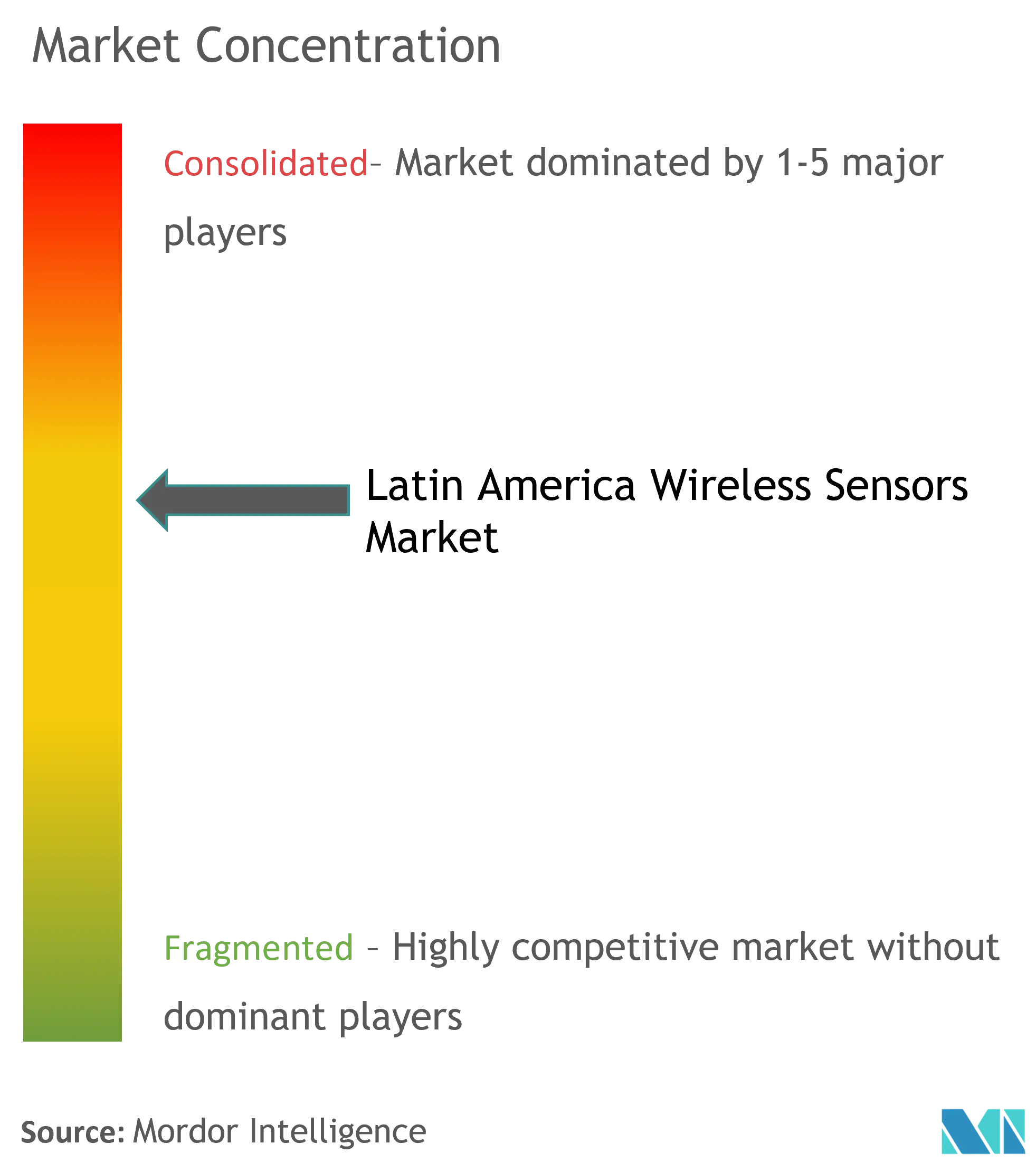Latin America Wireless Sensors Market Size

| Study Period | 2019 - 2029 |
| Base Year For Estimation | 2023 |
| Forecast Data Period | 2024 - 2029 |
| Historical Data Period | 2019 - 2022 |
| CAGR | 18.50 % |
| Market Concentration | Medium |
Major Players
*Disclaimer: Major Players sorted in no particular order |
Latin America Wireless Sensors Market Analysis
The Latin American wireless sensor market is expected to register a CAGR of 18.5% during the forecast period (2021 - 2026). The COVID-19 outbreak forced companies worldwide to adjust their strategies to survive in the "new normal." The COVID-19 outbreak affected the various manufacturing industries, resulting in a temporary shutdown of industrial operations. The supply chains' disruption affected the production of consumer electronics, automotive, healthcare devices, and other sectors, which are prominent adopters of wireless sensors.
- Latin America is undergoing a technology boom, owing to the government's emphasis on telecommunications and the Chinese investment in the region, especially in emerging technologies. With the region's economy expected to be driven by Brazil and Argentina, consumer spending is also expected to increase further.
- Automotive and healthcare production substantiates the region's demand for wireless sensors. The region lacks the local production of aerospace and military equipment and other industrial control systems.
- Medical device manufacturing in Latin America is driven by Mexico, which is led by well-known global companies, including Medtronic, Kimberly Clark, GE, Boston Scientific, Johnson and Johnson, Tyco, Siemens, and Cardinal Healthcare Becton Dickinson, among others. Such a concentration of device manufacturers and contract manufacturers also contributes to Latin America's market for wireless sensors.
- Moreover, the growing number of private hospitals and increasing investments in the healthcare sector by foreign players are helping in boosting the Latin American IT healthcare industry. Fluctuating economic condition has driven the demand for low-cost medical equipment, thus creating a massive opportunity for wireless sensor vendors in the region.
- Further, the major challenge for the wireless sensors is the bandwidth since it is a wireless technology, along with the compatibility of the sensor with the previously installed variety of devices.
Latin America Wireless Sensors Market Trends
This section covers the major market trends shaping the Latin America Wireless Sensors Market according to our research experts:
Position and proximity sensor is Expected to Hold Significant Market Share
- Position sensors can detect an object's movement or calculate its relative position relative to a known reference point. Sensors of this type can also be used to detect the presence or absence of an object. Many sensor types perform comparable functions to position sensors that are worth mentioning. Motion sensors detect an object's movement and can be utilized to initiate an action. Proximity sensors can also identify when an object enters the sensor's range. As a result, both sensors could be classified as specialized position sensors.
- Wireless position sensors are used in automobiles to determine the steering wheel's position, pedals, seats, and other valves, knobs, and actuators. Position sensors are divided into three categories: angular, rotational, and linear. Wiper-arm potentiometers, optical reflection or imaging, and Hall-effect sensors are among the technologies used to sense position in these sensors.
- To meet industry requirements, the manufacturing business necessitates a high level of precision. To make high-quality products, manufacturers concentrate on two key parameters: measurement precision and thorough inspection. A position sensor monitors several essential properties, including profiling, width, height, step, gap, V-gap, edge, angle, bend, groove, and surface.
- HVAC systems, transportation systems, industrial equipment, mobile hydraulics, smart buildings, heavy-duty gear, and construction equipment can all benefit from these sensors, which detect, measure, and assess the profiles on various object surfaces. When the position sensor is connected with the analytics software, many measurement jobs become more accessible. As a result, the wireless position sensor is ideal for automating, testing, or monitoring operations where displacement, distance, length, or position parameters need to be detected.
- Further, position sensors are made/assembled with various components from several vendors, including position magnets, sensing rods, electronics housing fixtures, diagnostic light-emitting diodes (LEDs), and connectors. Profitability is primarily determined by the availability and cost of raw materials and components, as well as the length of time it takes to bring the finished product to market. The main challenge for enterprises in this area is expanding their manufacturing capabilities, producing higher-quality products, and lowering overall production costs.

Mexico Accounts for the Largest Market Share
- The food and beverage and retail industry in Mexico are one of the fastest-growing industries for wireless sensors globally. Sensors capable of transmitting data without any physical connections improve the hygiene of the overall production establishment and minimize the risk of contamination from production tools and machinery significantly.
- Food and beverage manufacturers increasingly depend upon automated controls to achieve higher consistency and quality. This, in turn, has fueled the demand for wireless sensors. The need to maintain plants' ideal temperature and humidity levels to manufacture various food items, such as bread, has led to the broader use of wireless sensors in Mexico.
- The rising demand for wireless sensors by the retail industry is fueling the growth of the market studied. Retail users use a wireless sensor network to ensure hygienic production, storage, and distribution of their products. A recent application in a bakery used a wireless network to monitor gas consumption in ovens.
- Monnit, a prominent low-cost remote monitoring solution and wireless sensors provider makes use of a wireless temperature sensor to monitor and record temperatures inside walk-in refrigerators and freezers, providing data for FDA requirements and notifications set to alert staff of temperature fluctuations, preventing product spoilage. The company helps to ensure food is safe, and companies are in compliance with its wireless sensors.
- Further, the Mexican industrial sector can be associated with the growing number of automotive manufacturing plants. Companies like Intel that focus on the autonomous vehicle space are investing in Mexico, the sixth global car exporter. The company is planning to contribute significantly to autonomous passenger vehicles in the market by the year 2024. As TPMS is mandated across most of the regions, the demand for wireless sensors is significant.

Latin America Wireless Sensors Industry Overview
The Latin American wireless sensor is highly competitive owing to multiple vendors providing wireless sensors to the domestic and international markets. The market appears to be moderately fragmented, and the major players with a prominent share in the market are focusing on expanding their customer base across international countries. Additionally, these companies are continuously innovating their products to increase their market share and increase their profitability. Some of the recent developments in the market are:
- March 2021 - Monnit announced the availability of its ALTA Soil Moisture Sensor to meet the AgriTech market's demands. The innovative Soil Moisture Sensor assists farmers, commercial growers, and greenhouse managers in easily connecting their precision irrigation operations to the Internet of Things (IoT).
- January 2021 - Everactive, a technology company that builds the Internet of Things (IoT) solutions, raised USD 35 million in funding to develop its battery-free wireless sensors. The funds will be used to accelerate sales, marketing, and product development of the company's battery-free wireless sensors for industrial applications. Moreover, Everactive's end-to-end monitoring solutions are aimed at high-volume industrial assets that are currently unmonitored or under-monitored due to the sheer volume.
Latin America Wireless Sensors Market Leaders
-
Honeywell International Inc.
-
Emerson Electric Co.
-
ABB Ltd.
-
Texas Instruments Incorporated
-
Pasco Scientific
*Disclaimer: Major Players sorted in no particular order

Latin America Wireless Sensors Market News
- June 2021 - Salunda launched a wireless sensor network for connectivity of critical production, operational, and safety systems in the oil and gas industry, such as Red Zone management. The Hawk wireless network can be retrofitted to existing infrastructure and rapidly commissioned while drilling activity continues, ensuring minimum downtime and disruption to productivity. The network can be integrated with third-party sensors and control systems to improve platform safety further, predict equipment failure, enhance production and operational efficiencies.
- January 2021 - Swift Sensors, a provider of industrial IoT sensor solutions, announced the launch of its secure wireless vaccine storage unit monitoring and alert system to enable medical facilities and pharmacies to monitor COVID-19 vaccine storage temperatures remotely, automate data logging, and respond quickly in case of an equipment problem or power failure.
Latin America Wireless Sensors Market Report - Table of Contents
1. INTRODUCTION
1.1 Study Assumptions and Market Definition
1.2 Scope of the Study
2. RESEARCH METHODOLOGY
3. EXECUTIVE SUMMARY
4. MARKET INSIGHTS
4.1 Market Overview
4.2 Industry Value Chain Analysis
4.3 Industry Attractiveness - Porter's Five Forces Analysis
4.3.1 Bargaining Power of Suppliers
4.3.2 Bargaining Power of Consumers
4.3.3 Threat of New Entrants
4.3.4 Threat of Substitutes
4.3.5 Intensity of Competitive Rivalry
4.4 Technology Snapshot
4.5 Impact of COVID-19 on the market
5. MARKET DYNAMICS
5.1 Market Drivers
5.1.1 Increasing Adoption of Wireless Technologies (Especially in Harsh Environments)
5.1.2 Emergence of Smart Factory Concepts (Industrial Automation)
5.2 Market Challenges
5.2.1 Higher Security Needs and Cost associated with the Sensor Products
5.2.2 Concerns pertaining to cybersecurity in the IoT space and recent developments
6. MARKET SEGMENTATION
6.1 By Type
6.1.1 Pressure Sensor
6.1.2 Temperature Sensor
6.1.3 Chemical and Gas Sensor
6.1.4 Position and Proximity Sensor
6.1.5 Other Types
6.2 By End-user Industry
6.2.1 Automotive
6.2.2 Healthcare
6.2.3 Aerospace and Defense
6.2.4 Energy and Power
6.2.5 Food and Beverage
6.2.6 Other End-user Industries
6.3 By Country
6.3.1 Mexico
6.3.2 Brazil
6.3.3 Argentina
6.3.4 Rest of the Latin America
7. COMPETITIVE LANDSCAPE
7.1 Company Profiles
7.1.1 Honeywell International Inc.
7.1.2 Emerson Electric Co.
7.1.3 Texas Instruments Incorporated
7.1.4 Pasco Scientific
7.1.5 ABB Ltd.
7.1.6 Monnit Corporation
7.1.7 Schneider Electric
7.1.8 Siemens AG
7.1.9 Phoenix Sensors LLC
- *List Not Exhaustive
8. INVESTMENT ANALYSIS
9. FUTURE OUTLOOK OF THE MARKET
Latin America Wireless Sensors Industry Segmentation
The study characterizes the wireless sensors market based on the type of wireless sensors, the end-user industry, and the country. Wireless sensors are measurement tools for monitoring and recording the physical conditions of the environment. They are equipped with transmitters that convert signals from process control instruments into a radio transmission. These sensors have various applications in numerous sectors, such as automotive, healthcare, aerospace, etc. These have formed the part of the study in considering the end-user industry estimation. The scope of the study is currently focused on key regions, such as Mexico, Brazil, Argentina, etc. Further, to arrive at the overall market projections, the study analyzes the impact of COVID-19 and the investment scenario and other macro-economic factors.
| By Type | |
| Pressure Sensor | |
| Temperature Sensor | |
| Chemical and Gas Sensor | |
| Position and Proximity Sensor | |
| Other Types |
| By End-user Industry | |
| Automotive | |
| Healthcare | |
| Aerospace and Defense | |
| Energy and Power | |
| Food and Beverage | |
| Other End-user Industries |
| By Country | |
| Mexico | |
| Brazil | |
| Argentina | |
| Rest of the Latin America |
Latin America Wireless Sensors Market Research FAQs
What is the current Latin America Wireless Sensors Market size?
The Latin America Wireless Sensors Market is projected to register a CAGR of 18.5% during the forecast period (2024-2029)
Who are the key players in Latin America Wireless Sensors Market?
Honeywell International Inc., Emerson Electric Co., ABB Ltd., Texas Instruments Incorporated and Pasco Scientific are the major companies operating in the Latin America Wireless Sensors Market.
What years does this Latin America Wireless Sensors Market cover?
The report covers the Latin America Wireless Sensors Market historical market size for years: 2019, 2020, 2021, 2022 and 2023. The report also forecasts the Latin America Wireless Sensors Market size for years: 2024, 2025, 2026, 2027, 2028 and 2029.
Latin America Wireless Sensors Industry Report
Statistics for the 2023 Latin America Wireless Sensors market share, size and revenue growth rate, created by Mordor Intelligence™ Industry Reports. Latin America Wireless Sensors analysis includes a market forecast outlook to 2029 and historical overview. Get a sample of this industry analysis as a free report PDF download.



